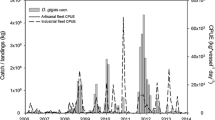Abstract
Jigging with artificial lights (squid jigging) and deploying of large scale trap-net (also known as a set-net in Japan), are the major methods to capture Japanese common squid Todarodes pacificus in western Japan. Squid jigging is a highly selective fishing method. However, it consumes large amount of energy for steaming to the fishing ground and for lighting. In contrast, trap-net fishing requires substantially less energy but its capture efficiency is strongly influenced by its stationary mode of capture. The primary objective of this study was to analyze how various environmental and biological factors such as the lunar cycle, tidal condition, wind direction and squid abundance affect the capture efficiency of squid jigging and trap-net fishing. We analyzed the effect of these factors on squid catch in five Fisheries Cooperative Associations located on four islands in Nagasaki Prefecture, western Japan. Our analysis shows that squid catch in jigging and trap-net fishing is mainly influenced by the lunar cycle but also tide and wind direction play a marked role. In addition, squid abundance significantly affects the catches in trap-net fishing. Recommendations are made to improve the overall profitability of squid fishing by proper choice of the capture method, location and season.










Similar content being viewed by others
References
Food and Agriculture Organization (2005) Review of the state of world marine fishery resources. FAO Fish Tech Pap 457. FAO, Rome
Fisheries Agency, Japan (2012) Annual statistics on fishery and aquaculture production 2011. Fisheries Agency, Tokyo (in Japanese)
Kidokoro H (2009) Impact of climatic changes on the distribution, migration pattern and stock abundance of the Japanese common squid, Todarodes pacificus in the Sea of Japan. Bull Fish Res Agency 27:95–189 (in Japanese with English abstract)
Murata M (1990) Ocean resources of squid. Mar Behav Physiol 18:19–71
Sakurai Y, Kiyofuji H, Saitoh S, Goto T, Hiyama Y (2000) Changes in inferred spawning areas of Todarodes pacificus due to changing environmental conditions. ICES J Mar Sci 57:24–30
Choi SJ, Nakamura Y (2003) Analysis of the optimum light source output and lighting management in coastal squid jigging boat. Fish Eng 40:39–46 (in Japanese with English abstract)
Takayama T (2004) The relationship between costs and effects of fishing lights in the coastal squid jigging fishery. Report of annual meeting on squid resources. Japan Sea National Fisheries Research Institute, Niigata, pp 17–20 (in Japanese)
Hasegawa K (2010) Estimation of fuel consumptions and CO2 emission from Japanese fishing vessels. J Fish Tech 2:111–121 (in Japanese with English abstract)
Watanebe K, Tahara K, Fujimori Y, Shimizu S, Miura T (2006) Life cycle inventory of environmental burden on squid fisheries. Environ Sci 19:15–24 (in Japanese with English abstract)
Suuronen P, Chopin F, Glass C, Løkkeborg S, Matsushita Y, Queirolo D, Rihan D (2012) Low impact and fuel efficient fishing—looking beyond the horizon -. Fish Res 119–120:135–146
Ogino R (1992) The relationship between frequency composition of mantle length by developmental stage, Loligo edulis, in the Eastern China Sea. Bull Kanagawa Pref Inst Fish 14:65–70 (in Japanese)
Yamashita Y, Matsushita Y, Azuno T (2012) Catch performance of coastal squid jigging boats using LED panels in combination with metal halide lamps. Fish Res 113:182–189
Matsushita Y, Yamashita Y (2012) Effect of a stepwise lighting method termed “stage reduced lighting” using LED and metal halide fishing lamps in the Japanese common squid jigging fishery. Fish Sci 78:977–983
Masuda D, Kai S, Maekawa H, Yamashita Y, Matsushita Y (2013) Catch performance of coastal squid jigging boats equipped with underwater lamps having the shading structure. Nippon Suisan Gakkaishi 79:785–792 (in Japanese with English abstract)
Yamashita Y, Matsushita Y (2013) Evaluation of impacts of environmental factors and operation conditions on catch of the coastal squid jigging fishery—does the amount of light really matter? Fish Eng 50:103–112
Kiyota M, Okamura H (2005) Harassment, abduction, and mortality of pups by nonterritorial male northern fur seals. J Mammal 86:1227–1236
Yokota K, Minami H, Kiyota M (2011) Effectiveness of tori-lines for further reduction of incidental catch of seabirds in pelagic longline fisheries. Fish Sci 77:479–485
Ministry of Agriculture, Forestry and Fisheries, Japan (2010) Report of statistical survey on fishery management 2009. Ministry of Agriculture, Forestry and Fisheries, Tokyo (in Japanese)
Ministry of Agriculture, Forestry and Fisheries, Japan (2012) Marine product distribution statistics annual report 2009. Ministry of Agriculture, Forestry and Fisheries, Tokyo (in Japanese)
Matsushita Y, Azuno T, Yamashita Y (2012) Fuel reduction in coastal squid jigging boats equipped with various combination of conventional metal halide lamps and low-energy LED panels. Fish Res 125–126:14–19
Ogura M, Myokaku T (1972) Squid jigging fishing and fishing light. Nippon Suisan Gakkaishi 38:881–889 (in Japanese)
Shikata T, Shima T, Inada H, Miura T, Daida N, Sadayasu K, Watanabe T (2011) Role of shaded area under squid jigging boat formed by shipboard fishing light in the processes of gathering and capturing Japanese common squid, Todarodes pacificus. Nippon Suisan Gakkaishi 77:53–60 (in Japanese with English abstract)
Acknowledgments
We are grateful to members of the five Fisheries Cooperative and researchers of Nagasaki Prefectural Institute of Fisheries for their help in collecting data.
Author information
Authors and Affiliations
Corresponding author
Rights and permissions
About this article
Cite this article
Masuda, D., Kai, S., Yamamoto, N. et al. The effect of lunar cycle, tidal condition and wind direction on the catches and profitability of Japanese common squid Todarodes pacificus jigging and trap-net fishing. Fish Sci 80, 1145–1157 (2014). https://doi.org/10.1007/s12562-014-0799-6
Received:
Accepted:
Published:
Issue Date:
DOI: https://doi.org/10.1007/s12562-014-0799-6




